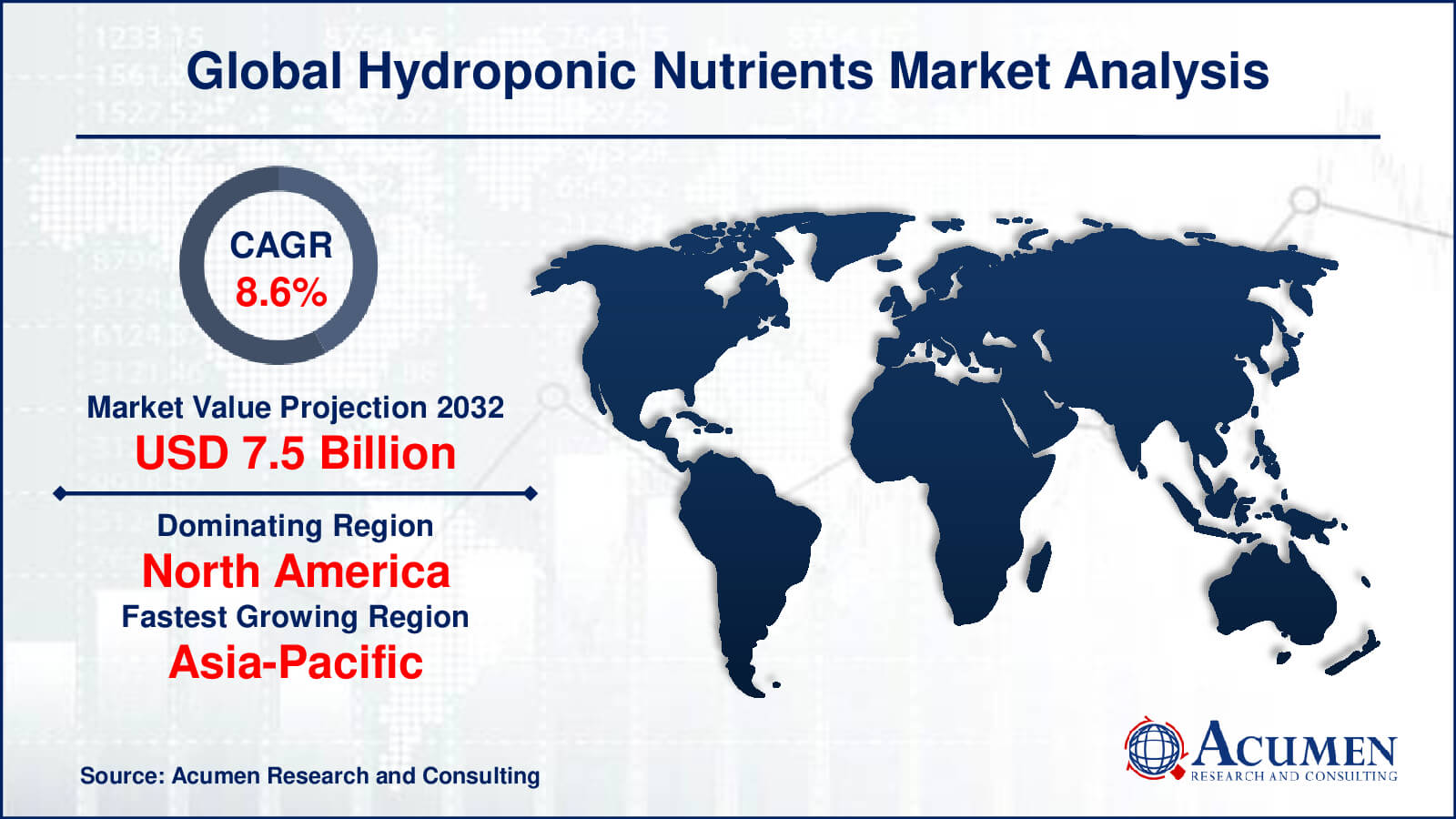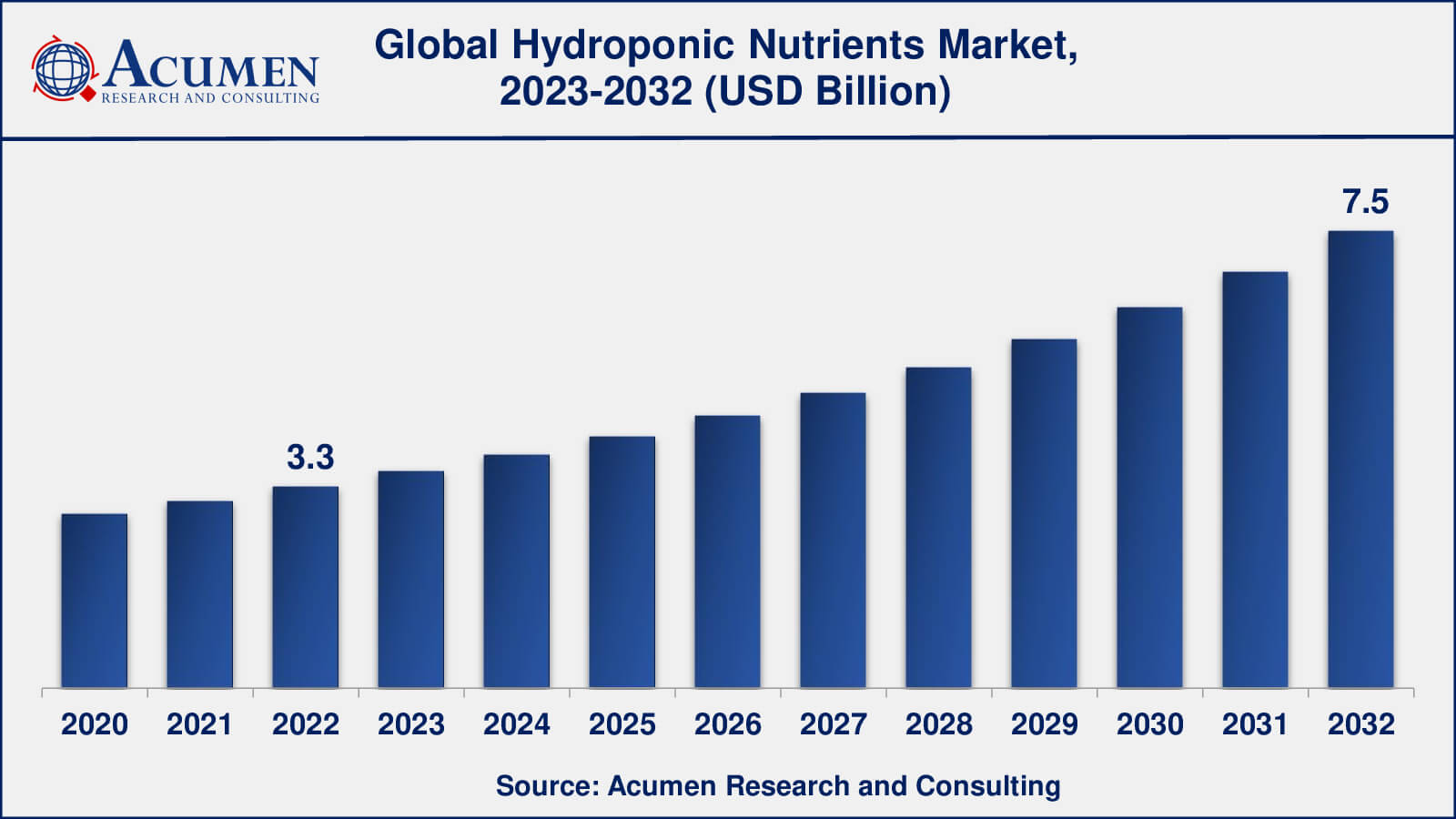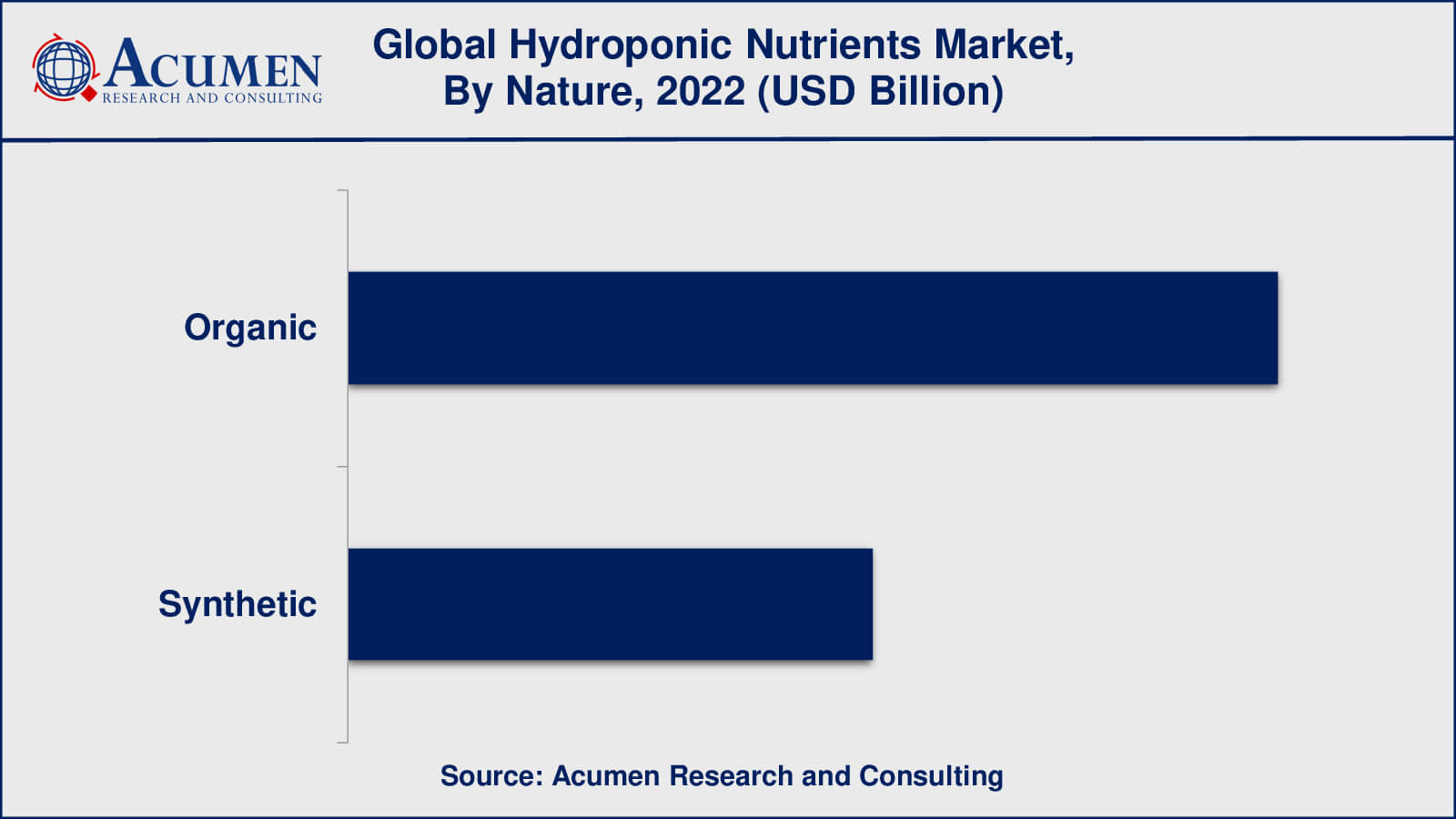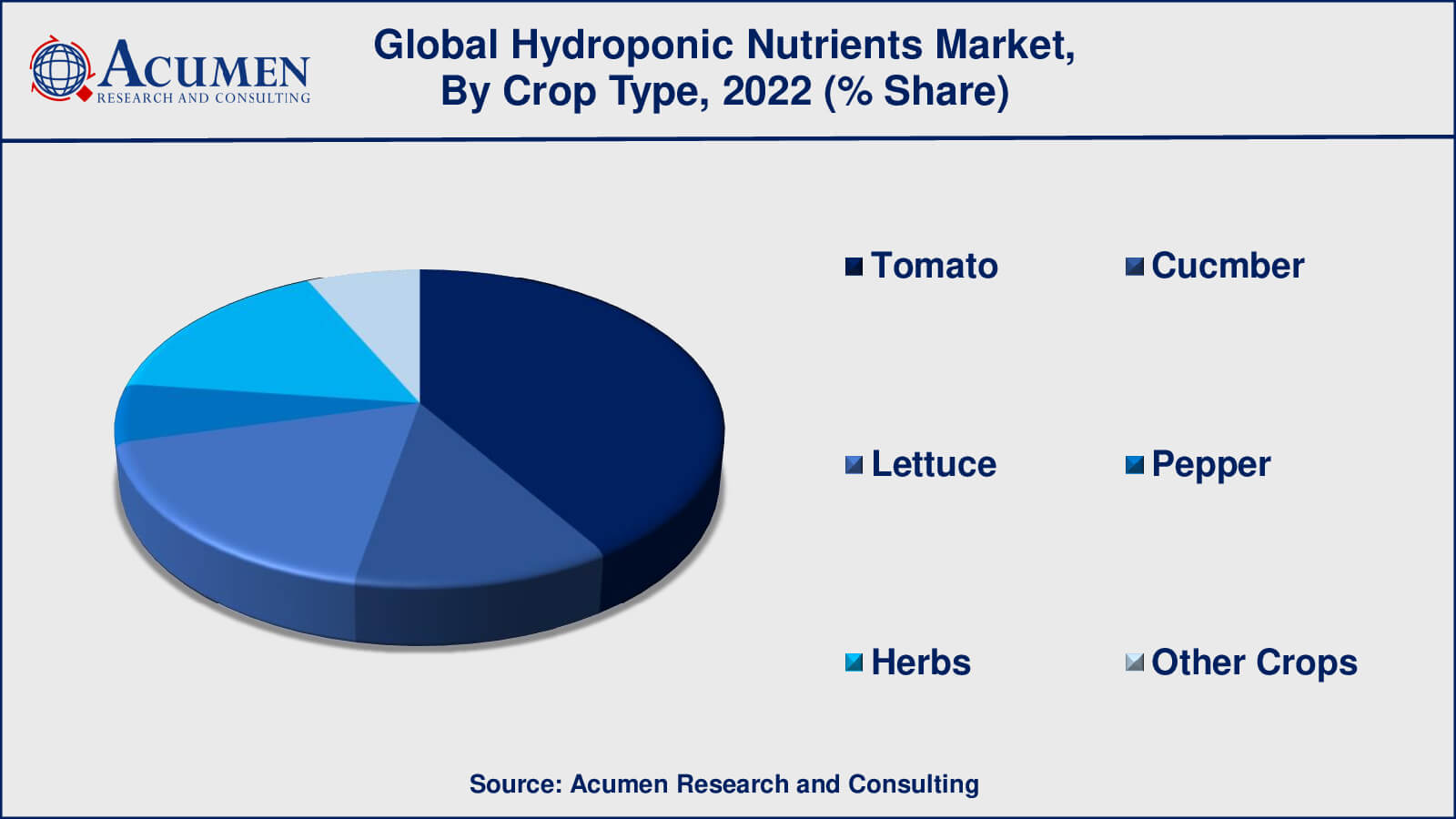July 2020
Hydroponic Nutrients Market Size accounted for USD 3.3 Billion in 2022 and is estimated to achieve a market size of USD 7.5 Billion by 2032 growing at a CAGR of 8.6% from 2023 to 2032.
The Global Hydroponic Nutrients Market Size accounted for USD 3.3 Billion in 2022 and is estimated to achieve a market size of USD 7.5 Billion by 2032 growing at a CAGR of 8.6% from 2023 to 2032.
Hydroponic Nutrients Market Highlights

Hydroponics is a method of farming that provides better as well as higher yields than conventional agricultural methods. The two Natures of inputs such as nutrients and medium are used apart from the equipment in the overall system. Micronutrients and macronutrients are the major Natures of nutrients used. Developed countries in Europe such as Netherlands and France are engaged in the utilization of hydroponics farming in greenhouse cultivation. Moreover, Scandinavian countries also take use of the hydroponic method of farming as growing crops in the winter season is often tough. Exotic plants, which are not found in certain regions due to their climatic conditions, can be easily grown using the hydroponic method of farming. Thus, hydroponic makes all Natures of fruits and vegetables available in several countries around the year.

Global Hydroponic Nutrients Market Dynamics
Market Drivers
Market Restraints
Market Opportunities
Hydroponic Nutrients Market Report Coverage
| Market | Hydroponic Nutrients Market |
| Hydroponic Nutrients Market Size 2022 | USD 3.3 Billion |
| Hydroponic Nutrients Market Forecast 2032 | USD 7.5 Billion |
| Hydroponic Nutrients Market CAGR During 2023 - 2032 | 8.6% |
| Hydroponic Nutrients Market Analysis Period | 2020 - 2032 |
| Hydroponic Nutrients Market Base Year | 2022 |
| Hydroponic Nutrients Market Forecast Data | 2023 - 2032 |
| Segments Covered | By Nature, By Type, By Crop Type, And By Geography |
| Regional Scope | North America, Europe, Asia Pacific, Latin America, and Middle East & Africa |
| Key Companies Profiled | General Hydroponics, Advanced Nutrients, Botanicare, Hydrodynamics International, Canna, Dutch Nutrient Formula (DNF), Emerald Harvest, GHE (FloraNova), House & Garden, and Growth Technology among others. |
| Report Coverage |
Market Trends, Drivers, Restraints, Competitive Analysis, Player Profiling, Covid-19 Analysis, Regulation Analysis |
Hydroponic Nutrients Market Insights
The market is projected to rise significantly as key vendors are turning their attention towards innovation and the production of new and tailored products to boost sales. Moreover, rapid advancements in technology further ensure the expansion of the hydroponic farming system. For instance, a recently developed smartphone-operated plant growing system, Niwa is connected to the app and the internet. The system is easy to function, fully automated, and provides suitable conditions for growing variant crops.
Hydroponic Nutrients Market, By Segmentation
The worldwide market for hydroponic nutrients is split based on nature, type, crop type, and geography.
Hydroponic Nutrients Natures

According to the hydroponic nutrients industry analysis, there has been a growing trend in recent years towards the use of organic hydroponic nutrients. This is due to rising consumer demand for organic produce as well as heightened awareness of the potential health and environmental benefits of organic farming practises. As a result, in addition to their conventional, non-organic products, many hydroponic nutrient manufacturers are now offering organic options. Non-organic hydroponic nutrients, on the other hand, are still widely used, particularly in commercial hydroponic farming operations. This is because they are frequently less expensive and easier to obtain than organic alternatives while still producing high yields of high-quality crops.
Hydroponic Nutrients Types
Nitrogenous fertilisers are among the most commonly used hydroponic nutrients because they are required for the formation of amino acids, proteins, and other organic compounds required for plant growth. Phosphatic fertilisers are also important for plant growth because they aid in the development of strong roots as well as healthy flowers and fruits. Potassic fertilisers are required for water regulation in plant tissues as well as the development of healthy plant roots and stems.
Micronutrients like iron, zinc, and manganese are also necessary for plant growth, albeit in smaller amounts. They are frequently included in hydroponic nutrient formulations to ensure a balanced supply of nutrients and optimal plant growth.
Finally, the nutrient type chosen will be determined by the specific needs of the crop being grown as well as the stage of growth. Many hydroponic nutrient manufacturers provide a variety of nutrient formulations that can be tailored to specific crop needs and growing conditions.
Hydroponic Nutrients Crop Types

As per the hydroponic nutrients market forecast, tomatoes are one of the significant crop types in the hydroponic industry. Tomatoes are one of the most popular hydroponically grown crops due to their high yields, consistent quality, and low production costs. Hydroponic tomato cultivation enables year-round production and allows growers to achieve high yields in a small amount of space. Furthermore, hydroponic tomato plants are less prone to soil-borne diseases and pests, resulting in higher quality and more consistent yields. In recent years, there has been a steady increase in demand for hydroponic tomatoes, particularly in areas with limited arable land or harsh weather conditions. As a result, hydroponic nutrient manufacturers frequently offer specialised nutrient formulations optimised for tomato growth and yield.
Hydroponic Nutrients Market Regional Outlook
North America
Europe
Asia-Pacific
Latin America
The Middle East & Africa
Hydroponic Nutrients Market Regional Analysis
North America, particularly the United States and Canada, is a significant market for hydroponic nutrients. The growing demand for locally grown produce, as well as the need to overcome the challenges of traditional farming methods, has prompted the region's adoption of hydroponic farming. Because of the presence of large-scale hydroponic farming operations in this region, the use of hydroponic nutrients is high.
Asia Pacific, particularly China, Japan, and Australia, is a rapidly growing market for hydroponic nutrients. The rising demand for fresh produce, the need to overcome the difficulties of traditional farming methods, and the availability of low-cost labour have all contributed to the region's embrace of hydroponic farming. This area has a significant number of small-scale hydroponic farming operations, which contributes to the high use of hydroponic nutrients.
Hydroponic Nutrients Market Players
Some of the top hydroponic nutrients companies offered in the professional report include General Hydroponics, Advanced Nutrients, Botanicare, Hydrodynamics International, Canna, Dutch Nutrient Formula (DNF), Emerald Harvest, GHE (FloraNova), House & Garden, and Growth Technology.
Looking for discounts, bulk pricing, or custom solutions? Contact us today at sales@acumenresearchandconsulting.com
July 2020
October 2018
December 2024
February 2023